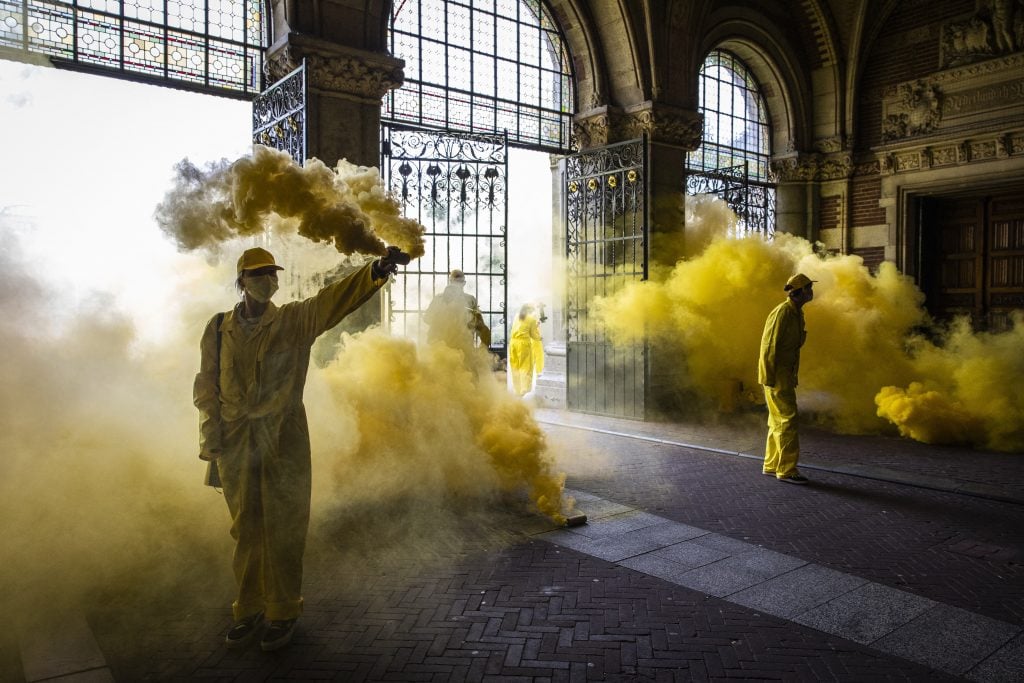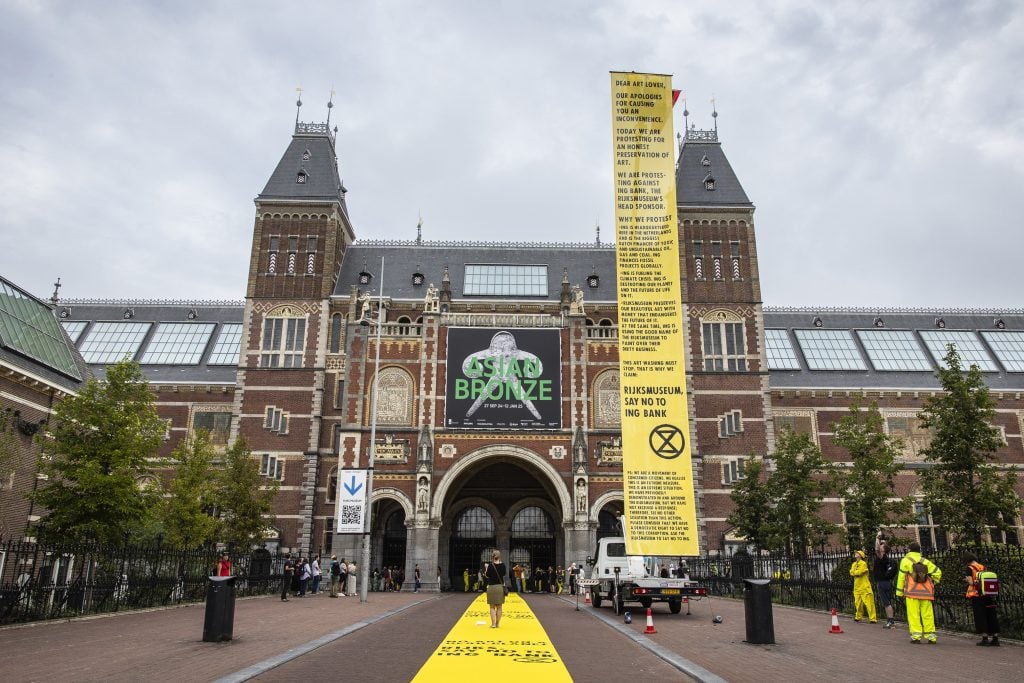Museums & Institutions
Climate Protesters Say They Will ‘Keep Coming Back’ After Shutting Down Rijksmuseum
The group accused the museum of letting ING Bank "hide its dirty face behind famous works of art from Dutch history."

The group accused the museum of letting ING Bank "hide its dirty face behind famous works of art from Dutch history."

Jo Lawson-Tancred

The Rijksmuseum in Amsterdam was temporarily shutdown by a large-scale demonstration by Extinction Rebellion. The climate campaigners, all dressed in yellow, occupied the main entrance to the museum and released dense yellow smoke, deterring potential visitors.
The museum was unable to open to the public on Saturday until the police had ended the demonstration, confirming today that it eventually opened at 2:45 p.m. Local reports claimed there were around 60 protestors dressed in yellow, of which roughly half were arrested.
The action was intended to protest the Rijksmuseum’s sponsorship deal with ING Bank, which has its headquarters in Amsterdam and is a sponsor of the Rijksmuseum. A tall yellow banner was erected outside the museum’s main facade written in the format of a letter. “Dear art lover,” it read, before detailing the protestors’ motivations.
The banner claimed that ING “is the biggest Dutch financ[i]er of toxic and unsustainable oil, gas, and coal,” and, “ING is fueling the climate crisis. ING is destroying our planet and the future of life on it.”

Climate activists of Extinction Rebellion, a global environmental movement, stage a protest blocking an entrance to the Rijksmuseum in Amsterdam on September 7, 2024, to protest against the museum’s main sponsor ING. Photo: Dingena Mol/ANP/AFP via Getty Images.
The letter went on to proclaim “Rijksmuseum, say no to ING Bank.” The slogan also appeared on smaller posters in the museum’s vicinity and was worn on some of the protestors’ chests. Another slogan read “no art on a dead planet.”
“By accepting money from ING, Rijksmuseum is allowing the big polluter to hide its dirty face behind famous works of art from Dutch history. This must stop!,” Extinction Rebellion Nederland wrote on the social media site X.
On its website, the Rijksmuseum confirms that ING is one of its “main sponsors,” with which it has partnered since 2005. It specified that, among various projects, the bank has helped support its satellite branch at Schiphol airport, ING Rijksmuseum Days for ING customers, and the museum’s “In het Rijksmuseum” podcast and digital tours program.
“If XR has a problem with ING’s financing policies, they should turn to us directly and not to the Rijksmuseum,” a spokesman for the bank told the news agency ANP. “We are always open to dialogue.”

Climate activists block the entrance to the Rijksmuseum as part of the global environmental movement Extinction Rebellion on September 07, 2024 in Amsterdam, Netherlands. Photo: Selman Aksunger/Anadolu via Getty Images.
The Extinction Rebellion activists chained themselves to the gates in The Passage, a public road running underneath the museum that is used as an access point by by pedestrians and cyclists. A museum spokesperson told ANP, that it decided to keep the museum closed for the safety of the collection, staff, and visitors. It said that, “any action that jeopardizes this is unacceptable.”
Extinction Rebellion Nederland confirmed that the protestors were untied and taken away by authorities in the early afternoon. It promised that “as long as the Rijksmuseum continues to be sponsored by ING, the largest financier of oil, gas, and coal companies of all Dutch banks, we will keep coming back!”
The Rijksmuseum is world renowned for its masterworks from the Dutch Golden Age, including The Milkmaid by Vermeer and Rembrandt’s Night Watch. Visitors who had a ticket for the Rijksmuseum on Saturday were able to use their ticket at any time over the weekend, a spokesperson for the museum confirmed.
Museums have become a regular site for climate protests in recent years. In some cases, demonstrators targeted artworks to draw attention to their cause. In other cases, they have staged blockades and sit-ins that directly challenge the museum’s own alleged complicity via corporate sponsorship deals.
Earlier this year, campaigners from two groups, Youth Action for Climate Justice and Scientists for Extinction Rebellion, held a demonstration at the Science Museum in London over its decision to let the coal-producing conglomerate Adani sponsor its “green energy gallery.” Protests by Energy Embargo for Palestine also took place at the British Museum after it controversially renewed a long-term partnership with BP last December.